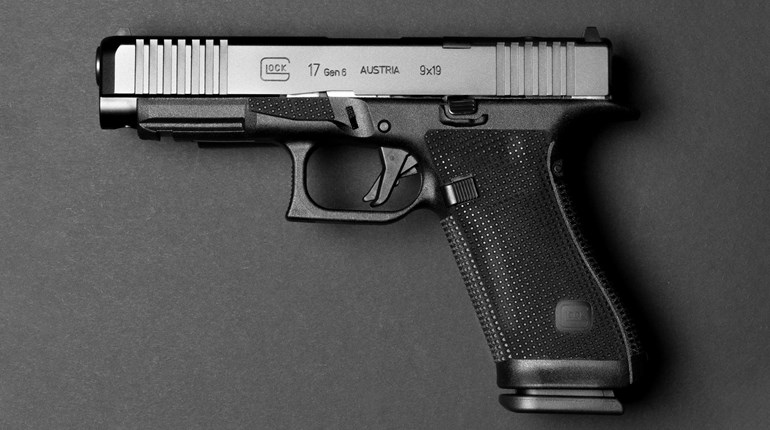
“Are you ready?” the mechanical voice of the Shooter Make Ready app asks. “Stand by.” A few seconds tick off, then you hear the beep and it’s time to shoot—only now you can shoot in your home with a SIRT Training Pistol, from NextLevel Training.
Since shooting is a perishable skill, it’s important to practice your technique. But for those times when you just don’t feel like going to the range, or maybe you don’t have the money to buy as much ammunition as you want, Accelerated Firearm Training offers a target set and app that will let you refine your trigger press, aim and reaction time.
Accelerated Firearm Training’s ad line is “Serious training that’s seriously fun.” Not only does the slogan fit, but the system offers options to fit almost every budget.
The premise is simple enough. You download the Shooter Make Ready app ($5.99) and buy an electronic target pack ($79 for one, $299 for four), get a SIRT gun ($239-$439), and pick up a few extras (the SIRT OneShot, a charger and charging cable)—then, with an easy set-up that even the technologically challenged (like yours truly) can handle, you’re good to go.
A SIRT Training Pistol, by itself, is a great tool for simulating drills that would be impractical with live ammunition or not allowed on a range. It’s designed not only to mirror the weight and feel of a real firearm, but it fits in holsters, has an adjustable trigger pull, can handle different sights and more. Those characteristics all add up to providing you with an accurate representation of live-fire shooting, minus the recoil.
The SIRT Training Pistol, which has been around for nearly a decade, can be used by itself or with a laser-reactive target. And, yes, you’ll get the immediate gratification of seeing if you score a hit on most target options. But when paired with the Shooter Make Ready app, you can move a step beyond by getting real-time feedback of you how well you’re shooting—and its scoring specs are pretty demanding.
The 2.5-inch-square targets are small enough to replicate a typical bullseye hits if your laser hits the target at all. But to get full credit for accuracy, you have to hit one of the four center pixel squares (each target includes a 16-by-16 array of the squares), so to max out your score, you’re restricted to a quarter-inch square zone—not a huge margin for error, but that’s one reason this app can be so beneficial. That also helps to explain why you can take 10 shots, hit the target every time, and end up with a success rate percentage that isn’t evenly divisible by 10. Basically, the scoring rate diminishes as your hits stray farther from the center four pixel squares.
The Shooter Make Ready app was about two years in the making, according to Kurt Schulz, managing member of Accelerated Firearm Training. As with most new products, it went through some changes during development. One objective was to find a way to let a shooter, at any level of experience and proficiency, benefit from a dry-fire system that measures accuracy, split times and more. At first, the idea was to fabricate a microcontroller that fit inside the SIRT Training Pistol. That gadget would measure trigger pull and trigger break, among other things, that would have been able to help shooters develop some key skills. Later, the concept about designing it as a target system arose, Schulz said.
The Shooter Make Ready app provides several advantages over other reactive targets.
One is that you have a variety of training options, including steel target shooting, where you use a timer and hit percentage to improve performance; reactive shooting, where any one of the targets can activate and you have to shoot that one under time constraints; Saturday steel, where you have flexibility in determining the course of fire for up to 10 stages; and practical shooting, where you race the clock and try to score a high hit factor.
Another plus is that the app analyzes your shooting. If you’re at the range and your hits are pulling down and left, for example, you might realize that you have to work on your trigger press. So, you can go home and set up one target, load your virtual magazine and shoot. Afterward, you can review your performance, not only via a visual representation of where the rounds hit, but you can superimpose a pie chart on top of it and find out whether you are jerking the trigger, breaking your wrist down or using too much or too little pressure on the trigger pull.
And, unlike some of the other technological options that exist to help you train, this one does not require a laptop and/or a camera system because the feedback system is integrated into the targets.
Another bonus is that the targets get recharged with a USB cable, so you don’t have to worry about buying batteries for it.
The app is designed to have expanded capabilities in the future, Schulz said.
One of extra components mentioned earlier, the SIRT One Shot, has a limitation in that it only works with the SIRT Training Pistol that is modeled after the Glock (NextLevel Training offers models based on the Glock 17/22 or the Smith & Wesson M&P). That said, it’s worth noting that the One Shot is not a mandatory component for the training system to work, Schulz said.
The SIRT is designed to emit a laser the entire time the trigger is held. That means the target and feedback system will read multiple hits on one trigger pull, so the user wouldn’t get the best results. That is not a problem for more experienced shooters who pull the trigger and release it for immediate reset, Schulz said. But the One Shot is helpful for new shooters.
The question about how much dry-fire training versus live-fire range time is optimal is probably not answerable, based on each individual’s needs and goals, but Schultz, himself a competitive shooter, said if you work in a few 20-minute dry-fire each week, that’s sufficient time to you work out any kinks in your shooting mechanics and to develop muscle memory. Because the SIRT is so close to the real gun it’s a replicate of, it and the Shooter Make Ready app let you practice drawing from the holster, presenting and lining up you sights as part of the drill.
And, in conjunction with the SIRT capabilities, you can put targets in different rooms and practice more practical skills, rather than just target shooting. Still, Schulz said it’s not a complete replacement for going to the range because one thing it will never do is allow you to experience recoil and learn to manage that.
One recommendation, from a personal standpoint, is to print out the User Guide so you don’t have to read it on your smartphone. This is especially important when it comes to getting a grasp of the different shooting scenarios, because it’s good to know why you’re incurring penalty time and how to use training parameters to get the maximum benefit from the system.


































